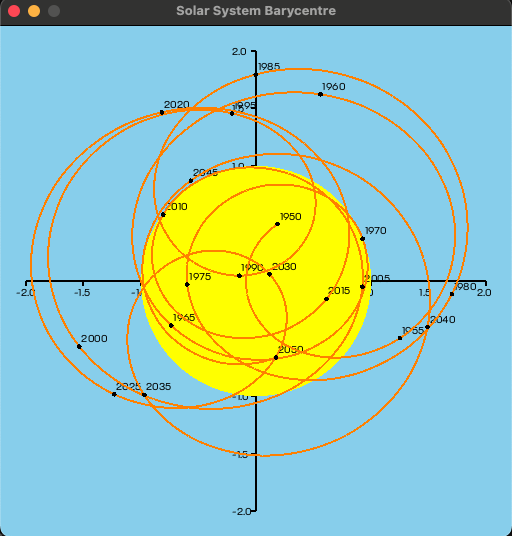Astrophysics
Orbital Motions
In order to predict astronomical events, it is necessary to know the positions of planets and moons at particular points in time. Johannes Kepler determined that orbits are elliptical through observation and geometry. Sir Isaac Newton refined the definition of orbits by describing gravity as an attractive force between masses. A description of Kepler’s laws can be found on this site.
The orbits of planets and moons are not true ellipses. This is because the gravitational effects of the planets are constantly changing the shape of the orbits of the other planets. To get more accurate predictions better models are required.
The VSOP87 data and ELP2000 data provide means of calculating the positions of the planets and the Moon respectively.
The NASA JPL Ephemerides use numerical integration to generate accurate positions for the Moon and planets from 1550 to 2050. There is a New Horizons web site. There is also ASCII data which take the form of Chebyshev polynomials for expert users. The data sets are often refered to as DE4XX. I started with DE430. These data sets get refined using space probe data. The latest data sets are DE440 and DE441. The computations required to use DE4XX data can be found on this site.
Orbital Resonance
The orbits of Neptune and Pluto cross each other. When Pluto is close to perihelion, it is inside the orbit of Neptune. If Pluto got too close to Neptune it would probably be ejected from the solar system. This currently can’t happen. The reason for this being that Pluto and Neptune are in a 2:3 resonance. This means that for every 2 orbits of Pluto, Neptune completes 3 orbits. This means that when Pluto is inside Neptune’s orbit, Neptune is always distant on average a quarter of an orbit away.
Jupiter’s moons Io, Europa and Ganymede are in a 1:2:4 resonance.
Barycentres
When one or more bodies are in orbit around a planet or a star, they don’t orbit around the centre of the parent body unless it is significantly more massive than the orbiting bodies. In fact all of the bodies in the system orbit around the centre of mass of the system. This is called the barycentre. The barycentre is usually in constant motion due to the fact that the centre of mass of a system constantly changes due to orbital motion.
Solar System Barycentre (SSB)
The Earth doesn’t orbit around the Sun. Rather the Sun and all of the planets orbit about the centre of mass of the Solar System which is called the Solar System Barycentre (SSB). The graph shows the position of the barycentre relative to the centre of the Sun using NASA DE440 data from 1950 to 2050. It shows just how much the SSB moves as the relative positions of the planets change. The units on the axes are one solar radius which is 696,340km. To put this in perspective, the Sun’s mass is 99.86% of the mass of the solar system and the SSB moves between the centre of the Sun and a solar radius outside of the Sun!

In the early 1950s and 1990s the SSB was close to the centre of the Sun. In the early 1980s and 2020s it was at a point some 600,000km above the surface of the Sun, around 1,300,000km from the centre of the Sun. All of this is mainly due to the mass of the gas giants Jupiter and Saturn. If they are both aligned on the same side of the Sun, they pull the SSB about a solar radius away from the centre of the Sun.
Earth-Moon Barycentre (EMB)
The Moon doesn’t orbit the Earth. The Earth is about 81 times more massive than the Moon. Other moons in the solar system are significantly less massive than their parent planet. The Earth and Moon both orbit about the EMB - the centre of mass of the Earth-Moon system. The EMB averages 4,671km from the Earth’s centre. This is about 75% of the Earth’s radius.
This means that the Earth most definitely doesn’t orbit the Sun! In fact it is the EMB that orbits the SSB! This has a curious effect on the time of the Earth’s perihelion. The perihelion should currently be on 3 January. In fact it varies from year to year from 2 - 5 January. This depends on the relative positions of the Sun, Earth, and Moon when the EMB is closest to the SSB.
